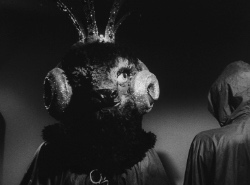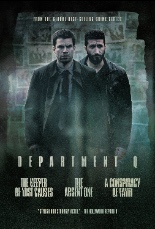
 Based upon Danish author Jussi Adler-Olsen’s series of crime novels — currently six volumes strong — The Department Q Trilogy collects the three films thus far, all smash hits in their Eastern Hemisphere homeland: 2013’s The Keeper of Lost Causes, 2014’s The Absent One and 2016’s A Conspiracy of Faith.
Based upon Danish author Jussi Adler-Olsen’s series of crime novels — currently six volumes strong — The Department Q Trilogy collects the three films thus far, all smash hits in their Eastern Hemisphere homeland: 2013’s The Keeper of Lost Causes, 2014’s The Absent One and 2016’s A Conspiracy of Faith.
After an act of questionable judgment that serves as The Keeper of Lost Causes’ holy-crap prologue, police detective Carl Mørck (Nikolaj Lie Kaas, Angels & Demons) finds himself downgraded to the basement’s Department Q, a new initiative in which he is to sort through 20 years of cold cases — essentially, a demeaning desk job that removes him from on-the-street investigation, which is one of the only two things at which he excels. The other is being an alcoholic.
 In Assad (Fares Fares, Rogue One: A Star Wars Story), Carl is assigned an assistant against his will, and something about the case of a missing politician (Sonja Richter, When Animals Dream) sparks Carl into actions he’s no longer supposed to pursue.
In Assad (Fares Fares, Rogue One: A Star Wars Story), Carl is assigned an assistant against his will, and something about the case of a missing politician (Sonja Richter, When Animals Dream) sparks Carl into actions he’s no longer supposed to pursue.
In The Absent One, Carl and Assad gain a secretary (Johanne Louise Schmidt, in quite a coup for her debut feature) and dig into a double murder presumably carried out by entitled prep-school bullies. Although the heinous crime was committed a generation prior, the fallout continues to spread like cancer in present day, thanks to a callous CEO (Pilou Asbæk, Lucy). Finally, A Conspiracy of Faith, involves a longtime serial killer (Pål Sverre Hagen, 2012’s Kon-Tiki) who preys upon the guileless and gullible followers of religious sects.
 While the mysteries at the heart of each film prove full-on riveting, The Department Q Trilogy is more than mere whodunit. Its installments — and, I suspect, Adler-Olsen’s books — are made special by the richness of two lead characters who could not be more different. Carl is a mess of a man (aided by Kaas’ weary, knuckle-sandwich mug) who believes only in the bottle, whereas Assad, an Arab, lives a life so orderly, it’s reflected not just in his thoughts, but in his daily sartorial choices. Part of the joy in binge-viewing the three is witnessing the duo’s relationship evolve: Lost Causes sees Carl barely tolerating anyone, himself included; by the time of Absent, they are more or less equals; and Conspiracy finds the team dynamic flipped, with Assad assuming point duty because Carl barely can function. The filmmakers assume audience members are smart enough to fill in the gaps between stories, rather than spell them out.
While the mysteries at the heart of each film prove full-on riveting, The Department Q Trilogy is more than mere whodunit. Its installments — and, I suspect, Adler-Olsen’s books — are made special by the richness of two lead characters who could not be more different. Carl is a mess of a man (aided by Kaas’ weary, knuckle-sandwich mug) who believes only in the bottle, whereas Assad, an Arab, lives a life so orderly, it’s reflected not just in his thoughts, but in his daily sartorial choices. Part of the joy in binge-viewing the three is witnessing the duo’s relationship evolve: Lost Causes sees Carl barely tolerating anyone, himself included; by the time of Absent, they are more or less equals; and Conspiracy finds the team dynamic flipped, with Assad assuming point duty because Carl barely can function. The filmmakers assume audience members are smart enough to fill in the gaps between stories, rather than spell them out.
With Lost Causes, director Mikkel Nørgaard (Klown) establishes a grounded world followed through with stylishness and consistency for his own follow-up and for Conspiracy, for which Hans Petter Moland (In Order of Disappearance) takes over in a seamless transition. Whether consumed individually or as a whole, these crackling crime procedurals come highly recommended and should fill the void left by the conclusion of the Dragon Tattoo’s own trilogy. Of course, once A Conspiracy of Faith reaches its end frame, your Department Q withdrawal will begin immediately. So B it. —Rod Lott

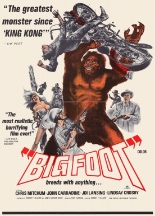
 James Stellar is Bigfoot, “The Eighth Wonder of the World,” as the opening credits of 1970’s
James Stellar is Bigfoot, “The Eighth Wonder of the World,” as the opening credits of 1970’s 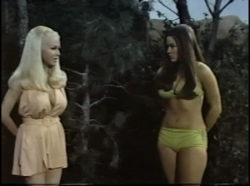
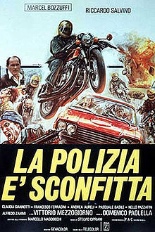
 In Italy, the crime rates have skyrocketed to such great heights, it’s enough to make a police commissioner throw his hands toward the sky in resignation and cry, “Mama mia!” What’s an authority figure to do? Well, there is always the idea of assembling a team of super cops who are not only crack shots, but aces on motorcycles — a
In Italy, the crime rates have skyrocketed to such great heights, it’s enough to make a police commissioner throw his hands toward the sky in resignation and cry, “Mama mia!” What’s an authority figure to do? Well, there is always the idea of assembling a team of super cops who are not only crack shots, but aces on motorcycles — a 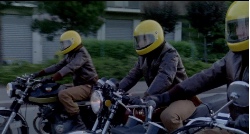
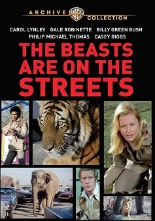
 Just as
Just as 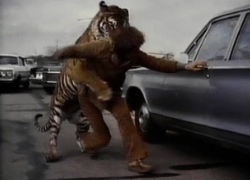 For this disaster-minded take on the Ivan Tors family comedy
For this disaster-minded take on the Ivan Tors family comedy 
 Who’s got the tricks to make a sex machine of all the chicks? Satan! The proof is in
Who’s got the tricks to make a sex machine of all the chicks? Satan! The proof is in 